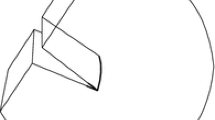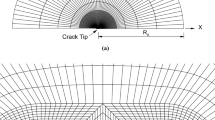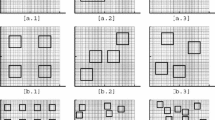Abstract
Ductile crack growth is analyzed by discrete representation of the voids growing near a blunting crack-tip. Coalescence of the nearest void with the crack-tip is modeled, followed by the subsequent coalescence of other discretely represented voids with the newly formed crack-tip. Necking of the ligaments between the crack-tip and a void or between voids involves the development of very large strains, which are included in the model by using remeshing at several stages of the plastic deformation. The material is here described by standard isotropic hardening Mises theory. For a very small void volume fraction the crack-tip tends to interact with one void at a time, while larger void volume fractions lead to simultaneous interaction of multiple voids on the plane ahead of the crack-tip. In some cases a change from one of these mechanisms to the other is seen during growth through the many voids represented here. First uniformly spaced voids of equal size are considered, but also a few computations for a random distribution of the void spacings or of the void sizes are carried out.
Similar content being viewed by others
References
Aravas N, McMeeking RM (1985) Finite element analysis of void growth near a blunting crack tip. J Mech Phys Solids 33: 25–49
Brocks WK, Klingbeil KD, Sun D-Z (1995) Application of the Gurson model to ductile tearing resistance. In: Kirk M, Bakker A(eds) Constraint effects in fracture: theory and applications. ASTM STP 1244, Philadelphia
Gao X, Faleskog J, Shih C-F, Dodds RH (1998) Ductile tearing in part-through cracks: experiments and cell-model predictions. Eng Frac Mech 59: 761–777
Gurson AL (1977) Continuum theory of ductile rupture by void nucleation and growth: Part I: Yield criteria and flow rules for porous ductile media. J Eng Mater Technol 99: 2–15
Hom CL, McMeeking RM (1989) Three-dimensional void growth before a blunting crack tip. J Mech Phys Solids 37: 395–415
Hutchinson JW (1973) Finite strain analysis of elastic-plastic solids and structures. In: Hartung RF(eds) Numerical solution of nonlinear structural problems. ASME, New York, p 17
McMeeking RM (1977) Finite deformation analysis of crack-tip opening in elastic-plastic materials and implications for fracture initiation. J Mech Phys Solids 25: 357–381
Needleman A, Tvergaard V (1987) An analysis of ductile rupture modes at a crack tip. J Mech Phys Solids 35: 151–183
Pedersen TØ (1998) Remeshing in analysis of large plastic deformations. Comput Struct 67: 279–288
Petti JP, Dodds RH Jr (2005) Ductile tearing and discrete void effects on cleavage fracture under small-scale yielding conditions. Int J Solids Struct 42: 3655–3676
Rice JR, Johnson MA et al (1970) The role of large crack tip geometry changes in plane strain fracture. In: Kanninen MF(eds) Inelastic behavior of solids. McGraw-Hill, New York, pp 641–672
Rousselier G (1987) Ductile fracture models and their potential in local approach of fracture. Nucl Eng Des 105: 97–111
Tvergaard V (1976) Effect of thickness inhomogeneities in internally pressurized elastic-plastic spherical shells. J Mech Phys Solids 24: 291–304
Tvergaard V (1997) Studies of void growth in a thin ductile layer between ceramics. Comput Mech 20: 186–191
Tvergaard V (2000) Interface failure by cavity growth to coalescence. Int J Mech Sci 42: 381–395
Tvergaard V (2004) On fatigue crack growth in ductile materials by cracktip blunting. J Mech Phys Solids 52: 2149–2166
Tvergaard V, Hutchinson JW (2002) Two mechanisms of ductile fracture: void by void growth versus multiple void interaction. Int J Solids Struct 39: 3581–3597
Tvergaard V, Needleman A (1992) Effect of crack meandering on dynamic, ductile fracture. J Mech Phys Solids 40: 447–471
Tvergaard V, Needleman A (2006) Three dimensional microstructural effects on plane strain ductile crack growth. Int J Solids Struct 43: 6165–6179
Author information
Authors and Affiliations
Corresponding author
Rights and permissions
About this article
Cite this article
Tvergaard, V. Discrete modelling of ductile crack growth by void growth to coalescence. Int J Fract 148, 1–12 (2007). https://doi.org/10.1007/s10704-007-9172-4
Received:
Accepted:
Published:
Issue Date:
DOI: https://doi.org/10.1007/s10704-007-9172-4




